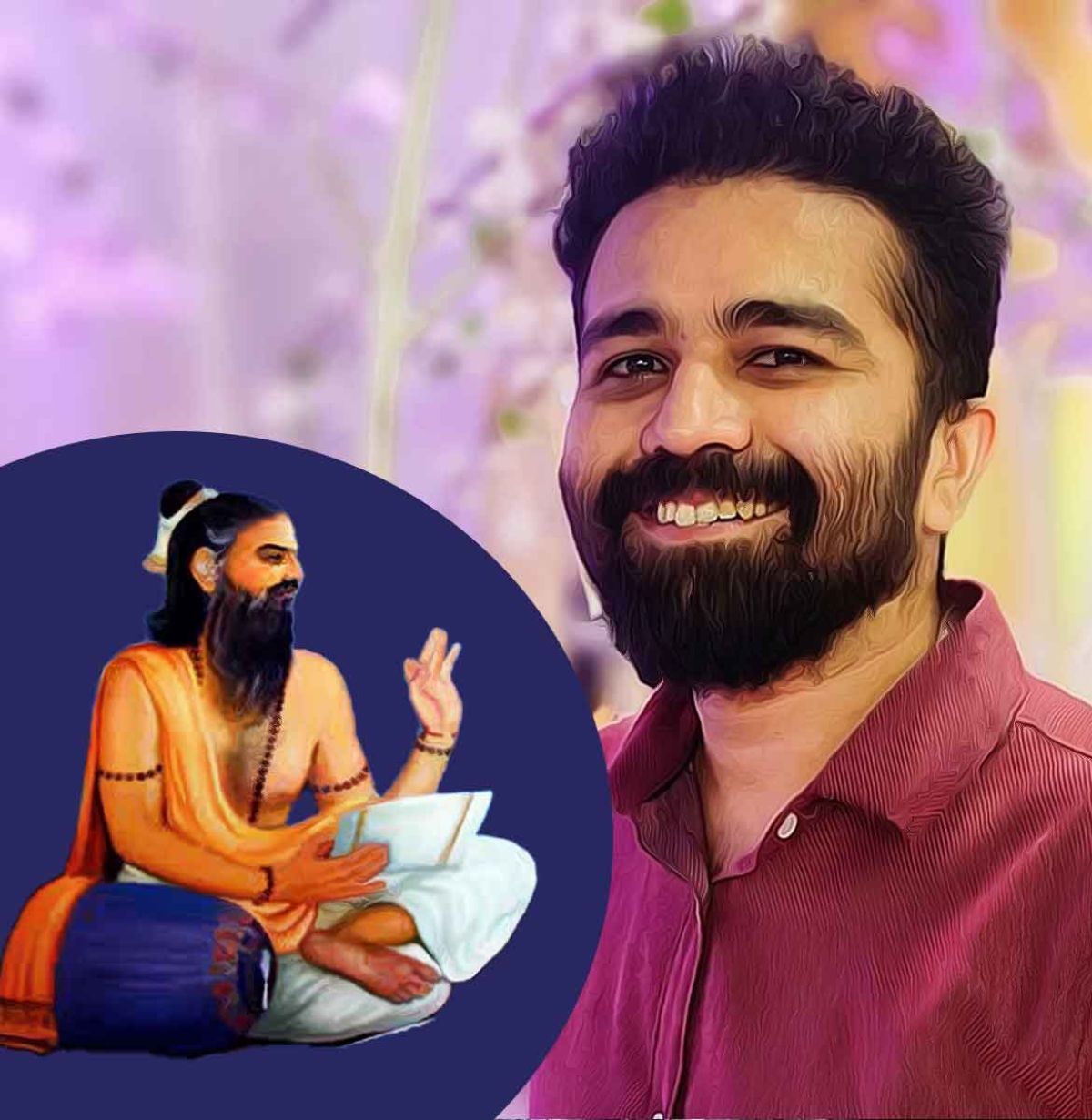More Coverage
Twitter Coverage
Satyaagrah
Written on
Satyaagrah
Written on
Satyaagrah
Written on
Satyaagrah
Written on
Satyaagrah
Written on
Join Satyaagrah Social Media
"The art of simplicity is a puzzle of complexity": Eureka Moment - Grammatical problem that puzzled Sanskrit scholars for 2,500 years is solved by Indian student Rishi Rajpopat at Cambridge, he decoded a rule taught by the "father of linguistics", Panini

Rishi Rajpopat, Ph.D. student at University of Cambridge, made a major breakthrough to solve a 2,500 years old problem that has been baffling Sanskrit scholars.
Decoding a rule taught by the father of linguistics, Panini, the discovery now makes it possible to derive Sanskrit words, that includes creation of “mantras” and “guru” using the language machine.
|
The Indian PhD scholar at the faculty of Asian and Middle Eastern studies at St. John’s College has decoded a rule in Panini’s text Ashtadhyayi.
Panini’s text Ashtadhyayi, which consists of a set of rules for deriving or forming new words from root words, frequently contains conflicting rules for creating new words, leaving many scholars perplexed about which rules to apply.
Many scholars were interested in resolving such a puzzle in this linguistic algorithm of a book. Panini himself wrote a meta-rule to resolve rule conflicts. According to Panini’s meta-rule (as interpreted by scholars over the years), In the occurrence of a conflict between two rules of equal strength, the rule that comes later in the grammar’s serial order is applicable.
Rajpopat’s thesis, titled – “In Panini, We Trust: Discovering the Algorithm for Rule Conflict Resolution in the Astadhyayi”, solves the issue of conflicting rules in Panini’s system, called Astadhyayi, where Sanskrit researchers could not predict the grammatically correct results.
Rajpopat said that he switched from Economics to Panani grammar for masters due to his interest in Sanskrit since school. “It’s just that the first commentator, who wrote around 150 years after Panini, got it wrong and then after everyone else ended up with the wrong interpretation up to before I wrote my thesis,” he explained.
Further, he said that there are 4000 rules in Panini’s grammar using which one can derive any word and subsequently any sentence of the language. “What happens though very often is that at certain depths of the derivation become simultaneously applicable. It was hard for me to believe that a genius would overlook something so central to the functioning of the system. It didn’t make sense to me,” he added saying that to add extra things to a system which he had written, because if he wanted to add extra things he would have.
“So instead of saying the machine doesn’t work, I decided to look at what our understanding of the machine is and tried to see if there are any errors in that. And that’s precisely what I did. I reinterpreted rule 142 (out of the 4000 rules),” said Rajpopat.
Rajpopat said that teaching natural language processing models how to combine a speaker’s intention with Panini’s rule-based grammar would be a milestone for producing human speech.
|
Rishi Rajpopat’s rebuttal to scholars over 2,500 years
Rejecting the traditional interpretation of the metarule, Rishi Rajpopat in his dissertation argued that Panini meant that between rules applicable to the left and right sides of a word respectively, Panini wanted the reader to choose the rule applicable to the right side.
For example, there is a rule conflict when attempting to form the word guruṇā, which means ‘by the guru’ and is a known word, in the sentence jna dyate guru — knowledge (jna) is given (dyate) by the guru (guru).
The word is made up of the roots guru + ā. Following Paini’s rules for creating the word that will mean “by the guru,” two rules become applicable: one to the word guru and one to ā. This is solved by selecting the rule that applies to the word on the right, which results in the correct new form guruṇā.
|
The eureka moment
As Rajpopat struggled to solve the problem, his supervisor at Cambridge Vincenzo Vergiani gave him a bit of insightful advice. “If a solution is complicated, you are probably wrong,” Vergiani advised Rajpopat.
Rajpopat reveals that there was a time when he had almost decided to give up however, after six months, he had a eureka moment. “Six months later, I had a eureka moment. I was all set to quit as I was getting nowhere. I closed my books for a month, and enjoyed meditating, praying, swimming, and other activities,” Rajpopat said.
“I then begrudgingly went back to work, and as I started turning pages, all the patterns started emerging and everything started making sense. I realised that the key to Panini’s grammar was right before everyone’s eyes but hidden from everyone’s minds for over 2 millennia,” Rajpopat added.
|
What is the Panini System?
The Panini system consists of 4,000 rules written in 500 BC that work like a large language model to generate grammatically correct sentences through a step-by-step process. This requires an algorithm. The “rule conflicts” in the Panini machine is where two or more rules are applicable at the same step. Panini developed several metarules to solve this but Sanskrit scholars could not interpret and decide which rule to use for the correct output.
Then the scholars developed several other metarules, but Rajpopot showed it is unnecessary and inefficient as the Panini’s “language machine” is itself sufficient. He found that Pāṇini’s “language machine” could produce grammatically correct words and sentences with almost no exceptions.
Rajpopat’s PhD supervisor, Professor Vincenzo Vergiani said that the discovery is revolutionising when the study of Sanskrit is a rising interest across the globe. He said, a potential practical use case of the research would be to teach computer human speech along with his colleagues from data science and computational linguistics.
Significance
Sanskrit is one of the oldest languages in the world and holds special importance in Hindu Dharma. It is through Sanskrit that much of India’s greatest science, philosophy, poetry, and other prominent literature has passed on over centuries.
Although the language is spoken in India by about 25,000 people presently, interest in the language has increased in recent years.
Speaking about ancient wisdom propagated by ancient Indian scholars, Rishi Rajpopat says, “We’ve been made to believe that we are not important. I hope this discovery will infuse confidence, a sense of pride, and hope among Indian students that they too can achieve great things.”
One of the major implications of this discovery by Rajpopat is that now the algorithm of Panini’s grammar is available, and this grammar can now be taught to computers.
“Teaching computers how to combine the speaker’s intention with Panini’s rule-based grammar to produce human speech would be a major milestone in the history of human-machine interaction, as well as in India’s intellectual history,” Rajpopat explains.
Speaking about his student’s extraordinary achievement, Vincenzo Vergiani, the Professor of Sanskrit at the University of Cambridge said, “My student Rishi has found an extraordinarily elegant solution to a problem that perplexed scholars for centuries. This will revolutionalize the study of Sanskrit.”
References:
 Support Us
Support Us
Satyagraha was born from the heart of our land, with an undying aim to unveil the true essence of Bharat. It seeks to illuminate the hidden tales of our valiant freedom fighters and the rich chronicles that haven't yet sung their complete melody in the mainstream.
While platforms like NDTV and 'The Wire' effortlessly garner funds under the banner of safeguarding democracy, we at Satyagraha walk a different path. Our strength and resonance come from you. In this journey to weave a stronger Bharat, every little contribution amplifies our voice. Let's come together, contribute as you can, and champion the true spirit of our nation.
 |  |  |
| ICICI Bank of Satyaagrah | Razorpay Bank of Satyaagrah | PayPal Bank of Satyaagrah - For International Payments |
If all above doesn't work, then try the LINK below:
Please share the article on other platforms
DISCLAIMER: The author is solely responsible for the views expressed in this article. The author carries the responsibility for citing and/or licensing of images utilized within the text. The website also frequently uses non-commercial images for representational purposes only in line with the article. We are not responsible for the authenticity of such images. If some images have a copyright issue, we request the person/entity to contact us at This email address is being protected from spambots. You need JavaScript enabled to view it. and we will take the necessary actions to resolve the issue.
Related Articles
- In a heartfelt farewell, Corbett Tiger Reserve Park says goodbye to Gomti, the devoted elephant, and Brandy, the faithful German Shepherd, their retirement tugs at heartstrings, reminding all of the deep bonds formed over years of dedicated service
- Ancient Someshwar Shiva temple in historical Raisen fort in Madhya Pradesh locked for many decades, opens only on Mahashivaratri for 12 hours: Attacked by Aurangzeb in 1682
- Exclusive visuals of Shivling inside the wuzukhana of Gyanvapi mosque compound surfaces, motifs of Swastika, Trishul, Lotus, and Hindu deities engraved on walls of the basement: clearest sign yet of existence of a Hindu temple
- "I am, always have been, and always will be proud of my Hindutva heritage": Durga Mata Doud - Spectacular Hindutva awakening in Navaratri festival for a cultural marathon, and how the proportion of girls and women participating is increasing every year
- Srikalahasti Temple, Dakshina Kailash
- The power of Sanatana Dharma and Fact Analysis of the Supernatural Fire Yogi of Tanjore
- The Often Misunderstood Icon - The Real Meaning of the Shiva's Linga Symbol
- “If we are to preserve culture we must continue to create it”: Bedara Vesha of Sirsi town is a unique folk dance with a legend of 300 years which is performed every alternate year to celebrate largest Holi festival of Karnataka, also known as Hunter Dance
- “A real friend is one who walks in when the rest of the world walks out”: PM Modi hails Indian relief teams work, says India strengthened identity as a selfless country, India launched 'Operation Dost' for assistance to Turkey and Syria after earthquake
- "यत्र तत्र": Discovered in Maharashtra, a stunning 11th-century Vishnu murti, intricately carved from chlorite schist and depicting the legendary Samudramanthana, ignites local pride and historical debates as Sindkhed Raja and ASI dispute its final home
- Savitri Devi broke into tears when Yogi Adityanath decided to leave for Gorakhpur to take vow of sainthood, and today her eyes contain the same tears brimming with pride Yogi has emerged as a Chief Minister of Uttar Pradesh
- "Aum Mahadevaya Namaha - The Great Universal God": Sanatana Dharma forces human mind, time and time again, to accept the fact that Divine is all that exists, both clean and unclean, pure and impure, auspicious and inauspicious
- "Respect is earned. Honesty is appreciated. Trust is gained": A Melody of Respect: American Singer Mary Millben sings the soulful rendition of the Indian National Anthem in a Heartfelt homage to India, touches the feet of Prime Minister Modi at Washington
- "Crumbling Chronicles, their stories yearn to be retold": Each intricately carved stone horse in the Pir Panjals carries a profound secret. Once symbols of Bharat's grandeur, now overshadowed by indifference, and their plea for acknowledgment grows louder
- "Sringara Prakasa - Sanskrit poetry": Classical theater, dancers (Bharatanatyam, Odissi, Mohiniyattam) refer to Sringara as 'the Mother of all rasas, one of the nine rasas, usually translated as erotic love, romantic love, or as attraction or beauty
























